
Introduction
The ultrawide monitor market has really
gained a lot of traction in the last few years, and we remember testing the
LG 34UM95 back in September 2014 when the 34" sized displays started to
appear. At the time they were aimed at general all-round uses, with a massive
screen size and resolution being offered from IPS technology panels to deliver a
decent overall performance. Since then, the market has shifted somewhat with
many gamer-orientated options emerging in the last couple of years. The
ultrawide aspect ratio creates an interesting option for an immersive gaming
experience, delivering a very wide field of view. Models in 34" and 35" sizes
are now pretty common, with options available based on IPS and VA panel
technologies. Manufacturers have switched to a curved screen format for more
comfortable viewing, pushed up the refresh rate in many cases to
improved frame rates and motion clarity, and added all kinds of extra features
designed to enhance the gaming experience overall.
In the IPS space, the two most popular
ultrawide gaming models are 34" in size, those being the
Acer Predator X34 (and also slightly updated X34a model) and
Asus ROG Swift PG348Q. We have reviewed them both in the past at the time of
release. These displays are built around a fairly old 60Hz refresh rate
IPS panel from LG.Display which has been used in a fair few screens in the past,
but which has now been overclocked to support up to 100Hz. This has been made
possible by the addition of an NVIDIA G-sync module, which also delivers the benefits of
a variable refresh rate. The response times are also strong from these models,
and (again thanks to the G-sync module) input lag is very low making them very
suitable to ultrawide gaming. The screens have
a fancy, futuristic design and come with some additional features like lighting
systems to separate them from the crowd. Those two 34" models have been very
popular since their release in early 2016.

Dell have now recently entered this segment
of the market with a model in their 'Alienware' gaming range to go alongside
their PC systems, mice and keyboards. They don't tend to
release many Alienware branded displays to be honest, but when they do they tend
to attract a lot of interest. Dell are well known in the monitor market,
carrying a good reputation that spans back over 10 years for making very good
screens and offering a great support service and warranty. The new Alienware
AW3418DW offers something a little new as well, compared with the Acer and Asus
models which have been the standard for 34" ultrawide IPS gaming for a while.
Rather than being based on a 60Hz refresh rate panel which needs overclocking up
to 100Hz, Dell have made use of a new 100Hz native refresh rate IPS panel. In
turn they have then boosted this up to 120Hz through an overclocking feature.
The screen supports NVIDIA G-sync and has a fancy "AlienFX" lighting system to
rival the competitors. We will take a look at all these features during this
review and provide comparisons against the Acer/Asus models as we go.
If you appreciate the review and enjoy reading and like our work, we would welcome a
donation
to the site to help us continue to make quality and detailed reviews for you.
|
Check Pricing and Buy - Direct Links
|
|
Amazon
|
|
TFTCentral is a participant
in the Amazon Services LLC Associates Programme, an affiliate
advertising programme designed to provide a means for sites to earn
advertising fees by advertising and linking to Amazon.com, Amazon.co.uk,
Amazon.de, Amazon.ca and other Amazon stores worldwide. We also
participate in a similar scheme for Overclockers.co.uk. |

Specifications and Features
The following table gives detailed information
about the specs of the screen as advertised:
|
Monitor
Specifications |
|
Size |
34"WS
ultrawide, 1900R curve |
Panel Coating |
Light AG coating |
|
Aspect Ratio |
21:9 |
Interfaces |
1x DisplayPort
1.2, 1x HDMI 1.4
|
|
Resolution |
3440 x 1440 |
|
Pixel Pitch |
0.233 mm, 109 PPI |
Design
colour |
Matt black bezel, silver
rear, black and silver metal stand |
|
Response Time |
4ms G2G |
Ergonomics |
Tilt, 130mm height, swivel |
|
Static Contrast Ratio |
1000:1 |
|
Dynamic Contrast Ratio |
n/a |
VESA Compatible |
Yes 100mm |
|
Brightness |
300 cd/m2 |
Accessories |
Power, DisplayPort, DP >
Mini DP, USB cables. |
|
Viewing Angles |
178 / 178 |
|
Panel Technology |
LG.Display IPS |
Weight |
with stand: 11.86 Kg |
|
Backlight Technology |
W-LED |
Physical Dimensions |
(WxHxD)
813.45 x 442.44 x 319.09 mm |
|
Colour Depth |
16.7m (8-bit) |
|
Refresh Rate |
100Hz native recommended
120Hz maximum overclocked
30 - 120Hz G-sync range |
Special
Features |
4x
USB 3.0 ports (1 with fast charging), audio line-in, headphone out, NVIDIA
G-sync, AlienFX lighting system |
|
Colour Gamut |
Standard gamut, 99% sRGB |
The AW3418DW offers a limited range of connectivity
options with 1x DisplayPort 1.2 and 1x HDMI 1.4
connections offered. This is a current limitation of NVIDIA G-sync modules, with
only two connections being available. Still, this should be enough for PC
connection and an external device if you want to. The
digital interfaces are HDCP certified for encrypted content and the video cables
are provided in the box for DisplayPort and a DP > Mini DP version only.
The screen has an internal power supply and comes
packaged with the power cable you need. There are also 4x USB 3.0 ports, 2 located on the back of
the screen with the video connections and 2 on the bottom edge. One of the ports
on the bottom edge offers fast charging support. A
headphone-out, and audio line-in connection are also provided
if you need them.
Below is a summary of the features and connections
of the screen:
|
Feature |
Yes / No |
Feature |
Yes / No |
|
Tilt adjust |
 |
DVI |
 |
|
Height adjust |
 |
HDMI |
 |
|
Swivel adjust |
 |
D-sub |
 |
|
Rotate adjust |
 |
DisplayPort |
 |
|
VESA compliant |
 |
Component |
 |
|
USB 2.0 Ports |
 |
Audio connection |
 |
|
USB 3.0 Ports |
 |
HDCP Support |
 |
|
Card Reader |
 |
MHL Support |
 |
|
Ambient Light Sensor |
 |
Integrated Speakers |
 |
|
Human Motion Sensor |
 |
PiP / PbP |
 |
|
Touch Screen |
 |
Blur Reduction Mode |
 |
|
Factory calibration |
 |
G-Sync |
 |
|
Hardware calibration |
 |
FreeSync |
 |
|
Uniformity correction |
 |
Wireless charging |
 |

Design and Ergonomics

The Dell Alienware AW3418DW comes in a black
and dark grey design. From the front view, matte black plastics are used
for the bezel which is a frameless design around the sides and top. Here
it measures only 1.5mm thick as a plastic edge, although there is then an
additional 8.5mm black panel edge before the image starts. So around the
sides and top there is a total border size of 10mm. along the bottom edge
is a total border of ~12.5mm thickness, made up of 1.5mm black panel
border and 11mm plastic bezel. The bottom edge of the screen then slopes
away from you at a slight angle. You can't see this bottom edge from a
normal viewing position, but it does allow the OSD buttons to stick out
slightly along the bottom right hand area making them visible just about.
There is a matte silver coloured "Alienware" logo in the middle of the
bottom bezel but no other writing or model designations on the front of
the screen.
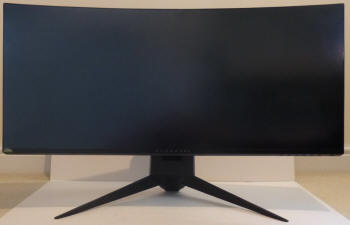
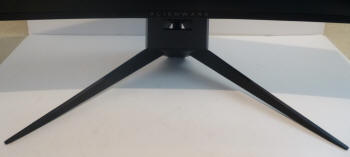
Above:
front views of the screen and stand. Click for larger versions
The stand is a very sturdy, and heavy
aluminium design. The foot of the stand provides a wide base for the
ultrawide format screen, which remains very stable on the desk and doesn't
wobble at all. The stand is quite deep at 319mm so you need a fairly deep
desk to be able to push the screen far enough back for it to be a
comfortable viewing distance.
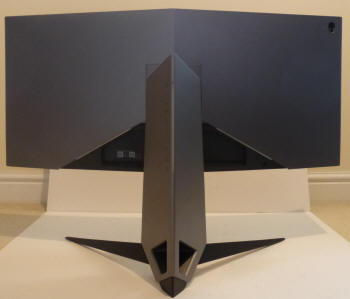
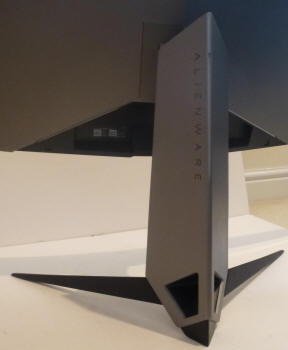
Above: rear views of the screen and stand. Click for larger versions
The back of the screen is encased in a dark
silver matte plastic as shown above. The back of the stand matches in colour
although that is a dark silver aluminium. You can see there is a cable tidy hole
through the bottom of the stand which is useful. This stand is big and chunky,
and very heavy, but it does provide a really solid foundation for the screen.
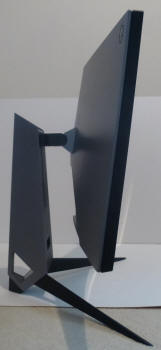
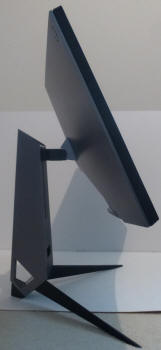
Above: full tilt range shown. Click for larger versions
There is a good set of ergonomic
adjustments offered from this screen. Tilt is smooth but fairly stiff to operate,
and offers a good range of adjustments as shown above.
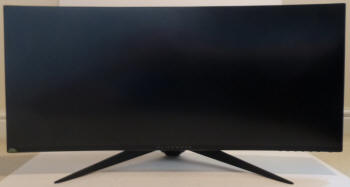
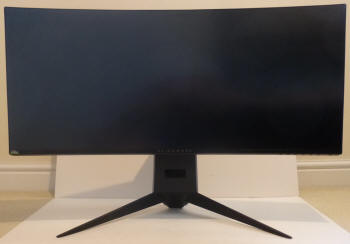
Above: full height adjustment range shown. Click for larger versions
Height
adjustment is a little stiff too but offers smooth movements, with a
total adjustment range of 130mm measured, as advertised. At the lowest setting the bottom edge of the
screen is ~60mm from the edge of the desk, and at maximum extension is is
~190mm.
Side to side swivel is also provided and is easier to re-position than the tilt and height.
It provides smooth movement as well. Overall the stand remains very stable on
the desk with no real wobble at all when you re-position it. It's heavy and
quite chunky, but it does a very good job. There is VESA 100 support as well if
you would rather wall or arm mount the screen.
A summary of the ergonomic adjustments
are shown below:
|
Function |
Range |
Smoothness |
Ease of Use |
|
Tilt |
Yes |
Smooth |
Fairly stiff |
|
Height |
130mm |
Smooth |
Fairly stiff |
|
Swivel |
Yes |
Smooth |
Easy |
|
Rotate |
No |
- |
- |
|
Overall |
Good set of adjustments.
A little stiff to move some, although the screen is very stable and sturdy |
The materials were of a very good standard and the
build quality felt good and robust There was no audible noise from the screen,
even when conducting specific tests which can often identify buzzing issues.
The whole screen remained cool even during prolonged use as well which
was pleasing.

Above: connection options on the back of the screen
The back of the screen features the
connections. There are the only DisplayPort 1.2 and HDMI 1.4 connections
offered, along with an audio in (to the left), USB upstream and 2x USB 3.0
downstream ports.
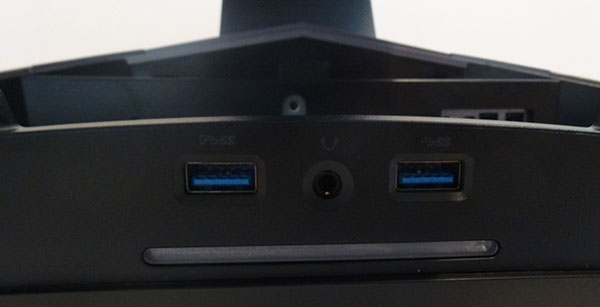
Above: USB
and headphone connections on the bottom edge of the screen
A further 2x USB downstream ports (1 with
fast charging) and the headphone port are located on the bottom edge of the
screen for easy access. We haven't see ports positioned here before actually,
as they are often on the right or left hand side of the screen if provided,
but it seemed to make more sense here in terms of keeping cables and
connections hidden and tucked out of the way. You will note the AlienFX
lighting strip on the bottom edge as well in the photo above.

OSD Menu

Above: OSD control buttons on the bottom edge of the screen
The OSD menu is controlled through a series
of 6 pressable buttons located on the bottom right hand edge of the screen. To
the right of these (not shown above) is a power button as well. Pressing any of
the 6 OSD buttons pops up the quick launch menu shown above, providing easy
access to the preset modes, overclocked refresh rate, dark stabilizer,
brightness/contrast and then the main menu. These quick launch options can be
changed if you want via the main menu as well which is handy.
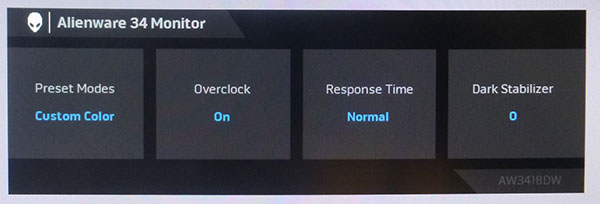
When you press any of the buttons you are
also presented with a summary of some of your key gaming settings at the top of
the screen as shown above. This gives you a quick confirmation of some settings in case
you wanted to check them briefly.
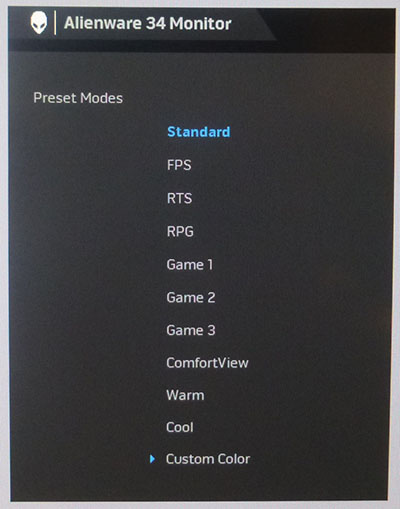
The preset mode quick launch menu is shown
above, giving you direct access to switch between the various modes if you want.
There are 3 user configurable game modes as well which is useful, and there are
several preset options for FPS, RTS and RPG gaming.
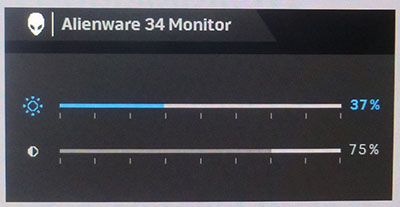
The quick access menu for brightness and
contrast is shown above.
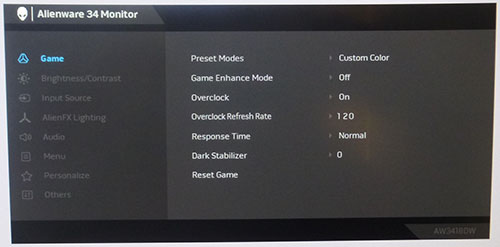
The main OSD menu is split in to 8 sections
shown down the left hand side, with the options available in each section then
shown on the right. The 'game' section has various useful options including the
overclocking feature,
response time and dark stabilizer control.
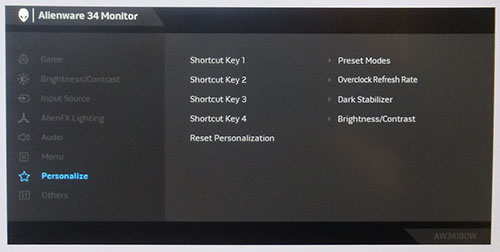
Most of the other sections are self
explanatory for input selection, lighting system (which we will look at
later
on), audio and options for the OSD menu itself. The 'personalize' menu shown
above allows you to tweak the quick access options if you want to.
All in all the menu navigation was quick and
easy, and felt pretty intuitive. There was a reasonable range of options to play
with and the software looked modern. No issues here.

Power Consumption
In terms of power consumption the
manufacturer lists typical usage of 60.0W, and 0.5W in standby. We carried out our normal tests to
establish its power consumption ourselves.
|
 |
|
State and Brightness
Setting |
Manufacturer Spec (W) |
Measured Power Usage
(W) |
|
Default (75%) |
60.0 |
54.3 |
|
Calibrated (37%) |
- |
39.8 |
|
Maximum Brightness (100%) |
- |
63.4 |
|
Minimum Brightness (0%) |
- |
26.0 |
|
Standby |
0.5 |
0.8 |
|
Out of the
box the screen used 54.3W at the default 75% brightness setting. Once calibrated the screen reached
39.8W consumption, and in standby it
used only 0.8W. We have plotted these results below compared with other screens
we have tested. The consumption is comparable to most of the other 34" -
35" sized
screens we have tested as you might expect, with some of the smaller 25 - 27" screens
drawing slightly less power (comparing the calibrated states).


Panel and Backlighting
|
Panel Manufacturer |
LG.Display |
Colour Palette |
16.77 million |
|
Panel Technology |
IPS |
Colour Depth |
8-bit |
|
Panel Module |
LM340UW4-SSA1 |
Colour space |
Standard Gamut |
|
Backlighting Type |
W-LED |
Colour space coverage (%) |
Quoted 99% sRGB |
Panel Part and Colour Depth
The Dell Alienware AW3418DW features an
LG.Display LM340UW4-SSA1 IPS technology panel which is capable of
producing 16.77 million colours. This is achieved through a native 8-bit colour depth.
This is a new panel from LG.Display,
different to the LM340UW2 which was used in the
Acer Predator X34/X34a and
Asus
ROG Swift PG348Q displays. That older panel was a native 60Hz refresh rate, which
was then overclocked to 100Hz maximum. This new LM340UW4 panel is a native 100Hz
refresh rate which means that the 100Hz should be stable on every system. That
gives it an edge compared with the older models which relied on an overclock to
reach that high, and didn't always achieve the full 100Hz. For instance we saw
some issues with the response time behaviour above 95Hz on the Asus model, and
some users had trouble achieving the maximum refresh rate on their graphics card
and system. With the Dell, since it is a native 100Hz panel this should not be a
problem. Dell have then also enabled an overclock, allowing you to boost the
refresh rate up to 120Hz maximum. We will test this
later on in the review.
Screen
Coating
The
screen coating is a light anti-glare (AG) like other modern IPS panels. It retains its anti-glare properties
to avoid too many unwanted reflections of a full glossy coating, but does not
produce an too grainy or dirty an image that some thicker AG coatings can,
including much older IPS panels.
There are some faintly visible cross-hatching patterns but nothing you should
notice during normal use unless you go looking for them very close to the
screen.
Backlight Type and Colour Gamut
The screen uses a White-LED (W-LED) backlight
unit which is standard in today's market. This helps reduce power consumption
compared with older CCFL backlight units and brings about some environmental
benefits as well. The W-LED unit offers a standard colour gamut which is
approximately equal to the sRGB colour space. Dell quote 99% sRGB coverage.
Anyone wanting to work with wider colour spaces would need to consider wide
gamut backlight screens or those which feature technologies such as Quantum Dot
for extending the colour space. If you want to read more about colour spaces and
gamut then please have a read of our
detailed article. Note that the Acer and Asus 34" models were also standard
sRGB gamut screens.
Backlight
Dimming and Flicker
We tested the screen to establish the methods used
to control backlight dimming. Our in depth article talks in more details about a
previously very common method used for this which is called
Pulse Width Modulation (PWM). This in itself gives cause for concern to some
users who have experienced eye strain, headaches and other symptoms as a result
of the flickering backlight caused by this technology. We use a photosensor +
oscilloscope system to measure backlight dimming control
with a high level of accuracy and ease. These tests allow us to establish
1) Whether PWM is being used to control the
backlight
2) The frequency and other characteristics at which this operates, if it is used
3) Whether a flicker may be introduced or potentially noticeable at certain
settings
If PWM is used for backlight dimming, the higher
the frequency, the less likely you are to see artefacts and flicker. The duty
cycle (the time for which the backlight is on) is also important and the shorter
the duty cycle, the more potential there is that you may see flicker. The other
factor which can influence flicker is the amplitude of the PWM, measuring the
difference in brightness output between the 'on' and 'off' states. Please
remember that not every user would notice a flicker from a backlight using PWM,
but it is something to be wary of. It is also a hard thing to quantify as it is
very subjective when talking about whether a user may or may not experience the
side effects.
100%
50%
0%



Above scale = 1
horizontal grid = 5ms
At all brightness settings a constant
Direct Current (DC) voltage seems to be applied to the backlight, and the
screen is free from the obvious off/on switching of any PWM dimming method.
The screen is flicker free as advertised.
|
Pulse Width
Modulation Used |
No |
|
Cycling
Frequency |
n/a |
|
Possible
Flicker at |
|
|
100% Brightness |
No |
|
50% Brightness |
No |
|
0% Brightness |
No |

Contrast
Stability and Brightness
We wanted to see how much variance there was in
the screens contrast as we adjusted the monitor setting for brightness.
In theory, brightness and contrast are two independent parameters, and good
contrast is a requirement regardless of the brightness adjustment.
Unfortunately, such is not always the case in practice. We recorded the
screens luminance and black depth at various OSD brightness settings, and
calculated the contrast ratio from there. Graphics card settings were left at
default with no ICC profile or calibration active. Tests were made using an
X-rite i1 Display Pro colorimeter. It should be noted that we used the
BasICColor calibration software here to record these, and so luminance at
default settings may vary a little from the LaCie Blue Eye Pro report.
|
OSD
Brightness |
Luminance
(cd/m2) |
Black
Point (cd/m2) |
Contrast
Ratio
( x:1) |
|
100 |
255.51 |
0.29 |
881 |
|
90 |
235.64 |
0.27 |
873 |
|
80 |
216.02 |
0.24 |
900 |
|
70 |
194.03 |
0.22 |
882 |
|
60 |
171.61 |
0.19 |
903 |
|
50 |
148.83 |
0.17 |
875 |
|
40 |
123.21 |
0.14 |
880 |
|
30 |
99.71 |
0.11 |
906 |
|
20 |
73.20 |
0.08 |
915 |
|
10 |
48.60 |
0.06 |
810 |
|
0 |
23.74 |
0.03 |
791 |
|
Total Luminance Adjustment Range
(cd/m2) |
231.77 |
Brightness OSD setting controls backlight? |
 |
|
Total Black Point
Adjustment Range (cd/m2) |
0.26 |
|
Average Static Contrast Ratio |
874:1 |
PWM Free? |
 |
|
Recommended OSD setting
for 120 cd/m2 |
39 |
The brightness control gave us a good range
of adjustment. At the top end the maximum luminance reached 256
cd/m2
which was a bit short of the specified maximum brightness of 300 cd/m2
from the manufacturer. This was in the default 'standard' preset mode and it was
possible to achieve slightly higher than this when switching to the 'Custom
Color' preset for example. There was a very good 232 cd/m2 adjustment range in total, and so at the minimum setting
you could reach down to a low luminance of 24 cd/m2. This should be
adequate for those wanting to work in darkened room conditions with low ambient
light. A setting of 39 in the OSD menu should return you a
luminance of around 120 cd/m2 at default settings.
It should be noted
that the brightness regulation is controlled without the need for
Pulse Width Modulation for all
brightness settings so the screen is flicker free.

We have plotted the
luminance trend on the graph above. The screen behaves as it should in this
regard, with a reduction in the luminance output of the screen controlled by the
reduction in the OSD brightness setting. This is basically a linear relationship as you
can see.

The average contrast ratio of the screen
was good (for an IPS panel) at 874:1 but this left it a little shy of the specified
1000:1. It remained mostly stable across the brightness adjustment range,
although dropped a little at the lowest settings below 20%.

Testing
Methodology
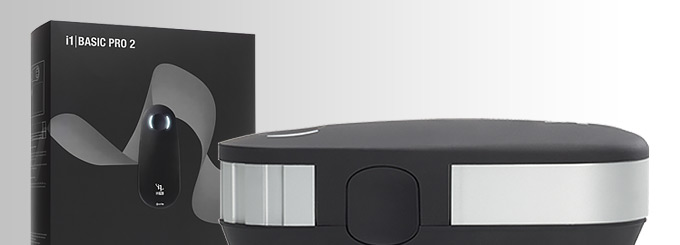
An
important thing to consider for most users is how a screen will perform out of
the box and with some basic manual adjustments. Since most users won't have
access to hardware colorimeter tools, it is important to understand how the
screen is going to perform in terms of colour accuracy for the average user.
We restored our graphics card to default settings
and disabled any previously active ICC profiles and gamma corrections. The
screen was tested at default factory settings using our new
X-rite i1
Pro 2 Spectrophotometer combined with
LaCie's Blue Eye Pro software suite. An X-rite i1 Display Pro colorimeter was
also used to verify the black point and contrast ratio since the i1 Pro 2
spectrophotometer is less
reliable at the darker end.
Targets for these tests are as follows:
-
CIE Diagram - validates the colour space
covered by the monitors backlighting in a 2D view, with the black triangle representing the
displays gamut, and other reference colour spaces shown for comparison
-
Gamma - we aim for 2.2 which is the default
for computer monitors
-
Colour temperature / white point - we aim
for 6500k which is the temperature of daylight
-
Luminance - we aim for 120
cd/m2, which is
the recommended luminance for LCD monitors in normal lighting conditions
-
Black depth - we aim
for as low as possible to maximise shadow detail and to offer us the best
contrast ratio
-
Contrast ratio - we aim
for as high as possible. Any dynamic contrast ratio controls are turned off here
if present
-
dE average / maximum -
as low as possible.
If DeltaE >3, the color displayed is significantly different from the
theoretical one, meaning that the difference will be perceptible to the
viewer.
If DeltaE <2, LaCie considers the calibration a success; there remains a
slight difference, but it is barely undetectable.
If DeltaE < 1, the color fidelity is excellent.

Default Performance and
Setup
Default settings of the screen were as follows:
Dell
Alienware AW3418DW
Default Settings



|

 |
|
Monitor OSD
Default Settings |
|
|
Preset Mode |
Standard |
|
Brightness |
75 |
|
Contrast |
75 |
|
RGB |
n/a |
|
Luminance
Measurements |
|
|
luminance (cd/m2) |
210 |
|
Black Point (cd/m2) |
0.23 |
|
Contrast Ratio |
896:1 |
|
Colour
Space Measurements |
|
|
sRGB coverage |
108.9% |
|
DCI-P3 coverage |
80.3% |
|
Rec.2020 coverage |
57.6% |
|
Initially out of the box the screen was set
with a high 75% brightness and so was a bit too bright and a bit uncomfortable to use, so you will
definitely need to turn that down. The colours felt bright and well balanced and
you could tell the screen was using a standard gamut backlight with a typical
sRGB colour space produced.
We went
ahead and measured the default state with the i1 Pro 2. The
CIE diagram
on the left of the image confirms that the monitors colour gamut (black
triangle) extends a little beyond the sRGB colour space (orange triangle). There is some minor over-coverage in
most shades,
but nothing significant. We measured using ChromaPure software a
108.9% sRGB gamut coverage so that met the spec of 99% nicely, and extended slightly
beyond that even. This measured colour space coverage corresponds to 80.3% of
the DCI-P3 reference and 57.6% of the Rec.2020 reference.
Default gamma was recorded at a high 2.6 average,
leaving it with a large 17% deviance
from the target which was potentially a bit of an issue. The gamma was most off
in light grey shades, and with no access to gamma controls in the OSD menu you
will need to rely on a calibration device if you want to correct that gamma
curve to bring it closer to a 2.2 target. White
point was measured at a very good 6597k which left it only 1%
out from the 6500k we'd ideally want for desktop use. There are a range of other
colour temp presets available in the menu along with a user configurable 'Custom
Color' mode
where you have access to the individual RGB channels for the
calibration
process.
Luminance was recorded at a fairly bright 210
cd/m2
which is too high for prolonged general use, you will likely need to turn
that down. The screen was set at a default
75% brightness in the OSD menu but that is easy to change of course to reach a
more comfortable setting without impacting any other aspect of the setup. The
black depth was 0.23 cd/m2 at this default
maximum brightness setting, giving us a fairly good (for an IPS panel) static contrast ratio of
896:1 which was a little lower than the specified 1000:1 figure.
Colour accuracy was moderate out of the box
with an average dE of 3.3, but a max of 5.4. Testing the screen with colour
gradients showed smooth gradients with only minor gradation evident in darker
tones. There was no sign of any colour banding which was good news.

Calibration
We used the
X-rite i1 Pro 2
Spectrophotometer combined with the LaCie Blue Eye Pro software package to
achieve these results and reports. An X-rite i1 Display Pro colorimeter was used
to validate the black depth and contrast ratios due to lower end limitations of
the i1 Pro device.
Dell
Alienware AW3418DW
Calibrated Settings



|

 |
|
Monitor OSD
Calibrated Settings |
|
Preset Mode |
Custom Color |
|
Brightness |
37 |
|
Contrast |
75 |
|
RGB |
93, 93, 100 |
|
Luminance
Measurements |
|
|
luminance (cd/m2) |
121 |
|
Black Point (cd/m2) |
0.14 |
|
Contrast Ratio |
840:1 |
|
Colour
Space Measurements |
|
|
sRGB coverage |
108.8% |
|
DCI-P3 coverage |
80.2% |
|
Rec.2020 coverage |
57.6% |
|
We first of all switched to the 'Custom
Color' preset mode which gives you access to adjust the RGB channels
individually. When you first switch to this mode the screen is quite noticeably
warmer than the 'Standard' preset, so we know we will need to bring down the red
channel at least. We adjusted the RGB
channels and brightness setting as shown in the table above as part of the
guided calibration process. These OSD
changes allowed us to obtain an optimal hardware starting point and setup before software level changes would be
made at the graphics card level. We left the LaCie software to calibrate
to "max" brightness which would just retain the luminance of whatever brightness
we'd set the screen to, and would not in any way try and alter the luminance at
the graphics card level, which can reduce contrast ratio. These adjustments
before profiling the screen would help preserve tonal values and limit
banding issues. After this we let the software carry out the LUT adjustments and create an
ICC profile.
Average gamma was corrected now nicely to 2.2
average which fixed the large 17% deviance we'd seen out of the box. The
minor 1% white point deviance had now been corrected bringing the measured
white point to 6526k. Luminance had been improved thanks to the adjustment to
the brightness control and was now being measured at a more comfortable 121
cd/m2.
This left us a black depth of 0.14 cd/m2 and a static
contrast ratio of 840:1. This was slightly lower than default (896:1) as we had
made adjustments to the gamma curve at the graphics card level to correct that
deviance. Colour accuracy of the resulting
profile was excellent, with dE average of 0.3 and maximum of 1.0. LaCie would
consider colour fidelity to be excellent.
Testing the screen with various colour
gradients showed mostly smooth transitions with only some minor gradation in
darker tones. There was a little added banding in medium dark shades which was
caused by adjustments to the
graphics card LUT from the profiling of the screen to correct the gamma curve.
You can use our settings and
try our calibrated ICC profile if you wish, which are available in
our ICC profile database. Keep in mind that results will vary from one
screen to another and from one computer / graphics card to another.

Calibration Performance Comparisons

The comparisons made in this section try to give
you a better view of how each screen performs, particularly out of the box which
is what is going to matter to most consumers. We have divided the table up by
panel technology as well to make it easier to compare similar models. When comparing the default factory
settings for each monitor it is important to take into account several
measurement areas - gamma, white point and colour accuracy. There's no point
having a low dE colour accuracy figure if the gamma curve is way off for
instance. A good factory calibration requires all 3 to be well set up. We have
deliberately not included luminance in this comparison since this is normally
far too high by default on every screen. However, that is very easily controlled
through the brightness setting (on most screens) and should not impact the other
areas being measured anyway. It is easy enough to obtain a suitable luminance
for your working conditions and individual preferences, but a reliable factory
setup in gamma, white point and colour accuracy is important and some (gamma
especially) are not as easy to
change accurately without a calibration tool.
From these comparisons we can also compare the
calibrated colour accuracy, black depth and contrast ratio. After a calibration
the gamma, white point and luminance should all be at their desired targets.

Default setup of the screen out of the box
was moderate. The gamma was the main issue with a 17% deviance, and a 2.6
average curve. That will need adjustment through calibration and screen
profiling to bring more in line with the 2.2 target, in the absence of any other
gamma modes in the OSD menu. The white point was much closer to the target and
dE was moderate.
If we compare the AW3418DW to the popular
Acer and Asus models we can see some slight variation. The Acer and Asus models
had a more accurate default gamma setup closer to the 2.2 target. Although they
did have a slightly warmer white point and showed a small 5 - 6% deviance from
the 6500k target. We would probably say that the default setup of those models
was a bit better because of the gamma curve to be honest.


The display was a little weak when it came to
contrast ratio reaching only 840:1 after calibration. This wasn't bad per se, it
just wasn't as good as the typical 1000:1 range we would expect to see from a
modern IPS panel. The Acer Predator X34 reached 1033:1 while the Asus ROG Swift
PG348Q reached 1090:1 so they performed a little better here when it came to
contrast ratio. The contrast ratio of the AW3418DW was more on par with the TN Film technology models shown
here. None of the IPS or TN Film models can live up to the high contrast ratios of VA technology
of course.
|
Check Pricing and Buy - Direct Links
|
|
Amazon
|
|
TFTCentral is a participant
in the Amazon Services LLC Associates Programme, an affiliate
advertising programme designed to provide a means for sites to earn
advertising fees by advertising and linking to Amazon.com, Amazon.co.uk,
Amazon.de, Amazon.ca and other Amazon stores worldwide. We also
participate in a similar scheme for Overclockers.co.uk. |

Viewing Angles
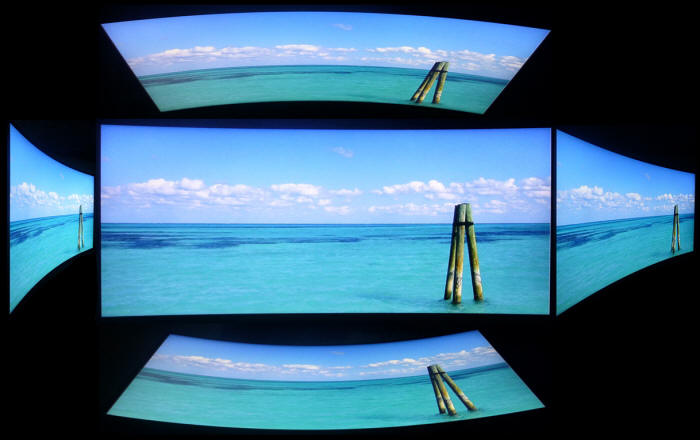
Above: Viewing
angles shown from front and side, and from above and below. Click for
larger image
Viewing angles of the screen were very good
as you would expect from an IPS panel. Horizontally there was very little colour
tone shift until wide angles past about 45. A slight darkening of the image
occurred horizontally from wider angles as you can see above as the contrast
shifted slighting. Contrast shifts were slightly more noticeable in the vertical
field but overall they were very good. The screen offered the wide viewing
angles of IPS technology and was free from the restrictive fields of view of TN
Film panels, especially in the vertical plane. It was also free of the
off-centre contrast shift you see from VA panels and a lot of the quite obvious
gamma and colour tone shift you see from some of the modern VA panel type
offerings. All as expected really from a modern IPS panel. For a gaming screen,
this is one of the big positives of using IPS panel technology as opposed to the
common TN Film matrices which are often adopted in gaming displays.
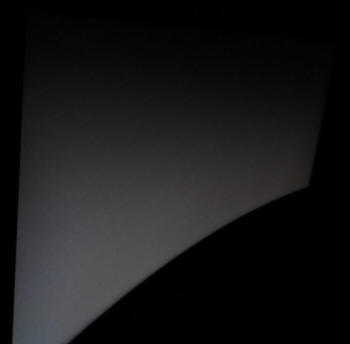
Above: View of an
all black screen from the side. Click for larger version
On a black image there is a characteristic
white glow when viewed from an angle, commonly referred to as "IPS-glow". This
is common on most modern IPS-type panels and can be distracting to some users.
If you view dark content from a normal head-on viewing position, you can
actually see this glow as your eyes look towards the edges of the screen.
Because of the sheer horizontal size of this 34" panel, the glow towards the
edges is more obvious than on small screens, where there isn't such a long
distance from your central position to the edges. Some people may find this
problematic if they are working with a lot of dark content or solid colour
patterns. In normal day to day uses, office work, movies and games you couldn't
really notice this unless you were viewing darker content. If you move your
viewing position back, which is probably likely for movies and games, the effect
reduces as you do not have such an extreme angle from your eye position to the
screen edges. The glow effect was a little less than on flat 34" ultra-wide
screens as the curved nature created a smaller angle between your eyes and the
edges of the screen. It was comparable to the Acer and Asus models incidentally.

Panel Uniformity
We wanted to test
here how uniform the brightness was across the screen, as well as identify any
leakage from the backlight in dark lighting conditions. Measurements of the
luminance were taken at 35 points across the panel on a pure white background.
The measurements for luminance were taken using BasICColor's calibration
software package, combined with an X-rite i1 Display Pro colorimeter with a
central point on the screen calibrated to 120 cd/m2. The below
uniformity diagram shows the difference, as a percentage, between the
measurement recorded at each point on the screen, as compared with the central
reference point.
It is worth
noting that panel uniformity can vary from one screen to another, and can depend
on manufacturing lines, screen transport and other local factors. This is only a
guide of the uniformity of the sample screen we have for review.

Uniformity of Luminance

Uniformity of the screen was moderate. The upper area of the screen and the
left/right hand sides were darker than the central and lower regions, which
luminance dropped down to a minimum of 102 cd/m2 ( -17.65%
deviance). Around 60% of the screen was within a 10% variance from the
centrally calibrated 120 cd/m2 point which was average. This
variance might be problematic for colour critical work, but remember this is
a gaming orientated screen and you shouldn't really see any issues in
practice with the luminance variation.

Backlight Leakage
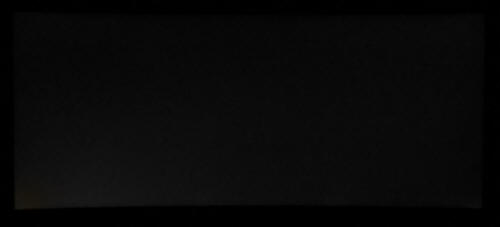
Above: All black screen in a darkened room. Click for larger version
We also tested the screen with an all black image
and in a darkened room. A camera was used to capture the result. The camera
showed there was some slight clouding in the bottom left hand corner of the screen.
Elsewhere the uniformity seemed to be good with no major leakage or bleeding. It would
be difficult to spot this during any normal uses really, unless you're viewing a
lot of dark content.
Note: if you want to test your own screen for
backlight bleed and uniformity problems at any point you need to ensure you have
suitable testing conditions. Set the monitor to a sensible day to day brightness
level, preferably as close to 120
cd/m2 as you can get it (our tests are
once the screen is calibrated to this luminance). Don't just take a photo at the
default brightness which is almost always far too high and not a realistic usage
condition. You need to take the photo from about 1.5 - 2m back to avoid
capturing viewing angle characteristics, especially on IPS-type panels where
off-angle glow can come in to play easily. Photos should be taken in a darkened
room at a shutter speed which captures what you see reliably and doesn't
over-expose the image. A shutter speed of 1/8 second will probably be suitable
for this.

General and Office Applications
One of the key selling points of ultra-wide
screens like the this is it's high resolution and large screen size. The 3440 x
1440 display offers a sharp but comfortable picture. Its pixel area is about 1.8
times larger than an Ultra-Wide Full HD 21:9 monitor, and about 2.4 times larger
than a Full HD 16:9 monitor. It provides an efficient environment in using
Microsoft Office programs showing 47 columns and 63 rows in excel. Thankfully
the high resolution is of a very comfortable size on the 34" panel, with a
0.2325mm pixel pitch is is very comparable to a 27" 2560 x 1440 monitor
(0.2331mm). This means you are basically getting a wider desktop to work with,
with a similar font size to a 27" model, and maintaining the same vertical
resolution as well. If you're coming from a lower resolution / larger pixel
pitch you may still find the fonts look quite small to start with, but like the
27" 1440p models out there you soon get used to it. Side by side multi-tasking
on this screen is excellent and you really do have a nice wide area to work
with. We liked the curved format of the display actually for day to day office
work. It just felt a bit more comfortable than a flat screen on a model as wide
as this, bringing the corners a bit nearer to you. You didn't really notice the
curve in normal use but we liked the feel. Probably down to user taste, so if in
doubt try and see one in person.
The light AG coating of the IPS panel doesn't
produce any graininess to the image like some aggressive AG solutions can and so
white office backgrounds look clean and clear. The wide viewing angles of the
IPS panel technology provide stable images from different angles, meaning you
can use the screen if you want for colour critical work, photos etc. It might be
orientated at gamers, but it's IPS panel can deliver strong performance in other
areas as well making it a good all-rounder. This panel technology still offers
the widest viewing angles and so is well-suited to colour work. Some contrast
shifts and IPS-glow may be evident because of the very wide size of the display,
as you glance towards the edges from a centrally aligned position. That's hard
to avoid on such a large desktop monitor from close up, even with IPS
technology.
The default setup of the screen was not ideal for general work since the gamma
curve was quite a long way off, but white point was at least accurate. The
contrast ratio was not amazing, but still pretty good for an IPS panel.
The
brightness range of the screen was also very good, with the ability to offer a
luminance between 256 and 24 cd/m2. This should mean the screen is
perfectly useable in a wide variety of ambient light conditions, including
darkened rooms. A setting of ~39 in the OSD brightness control should return you
a luminance close to 120 cd/m2 out of the box. On another positive
note, the brightness regulation is controlled without the need for the use of
the now infamous
Pulse-Width Modulation (PWM), and so those who suffer from eye fatigue or
headaches associated with flickering backlights need not worry.
There was no
audible noise from the screen, even when conducting specific tests which can
sometimes cause issues. The screen also remains cool even during prolonged use.
There is a specific 'ComfortView' preset mode for office work or reading if you
want which by default makes the image far more yellow. Still, you might be able
to set it to your liking for more reading.
The screen offers 4x USB 3.0 ports which can
be useful and it was nice to keep this up to date with the modern version. Two
are located handily on the bottom edge of the screen and one also offers fast
charging support. There are no integrated speakers but there is an audio input
and headphone output if you want. There are no further extras like ambient light
sensors or card readers which can be useful in office environments. Remember,
this is aimed at gamers really. There was a good range of ergonomic adjustments
available from the stand allowing you to obtain a comfortable position for a
wide variety of angles. They were mostly easy to use and it was nice to see side
to side swivel included as that often seems to be left off ultrawide screens
like this. The VESA mounting support may also be useful to some people as well
for more flexibility.
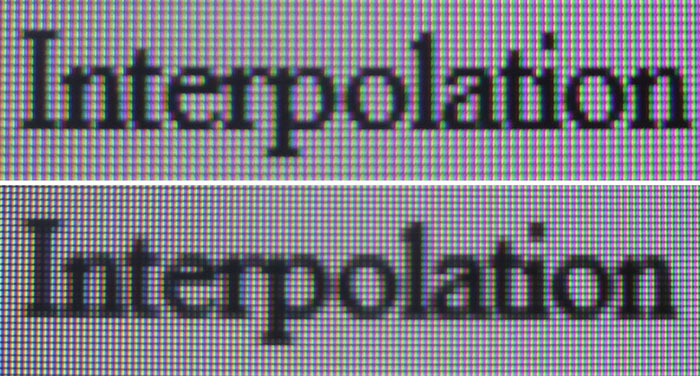
Above: photo of text at 3440 x 1440 (top) and 2560 x 1080 (bottom)
The screen is designed to run at its native
resolution of 3440 x 1440 and at a 100Hz native refresh rate. However, if you want you are able to run the screen
outside of this resolution. We tested the screen at a lower 2560 x 1080
resolution to see how the screen handles the interpolation of the resolution,
while maintaining the same aspect ratio of 21:9. At native resolution the text
was sharp and clear. When running at a the lower resolution the text
becomes noticeably more blurry. You do lose a lot of screen
real-estate as well of course but it might be a more manageable resolution for
some gaming if you want to push frame rates up to the upper end of the 100Hz
support.

Responsiveness and Gaming
|
Panel Manufacturer and
Technology |
LG.Display IPS |
|
Panel Part |
LM340UW4-SSA1 |
|
Quoted G2G Response Time |
4ms G2G |
|
Quoted ISO Response Time |
n/a |
|
Overdrive Used |
Yes |
|
Overdrive Control
Available Via OSD Setting |
Response Time |
|
Overdrive OSD Settings |
Normal, Fast, Super Fast |
|
Maximum
Refresh Rate |
100Hz (native)
120Hz (with overclock) |
|
Variable Refresh Rate
technology |
G-sync |
|
Variable Refresh Rate Range
|
30 - 120Hz |
The Alienware AW3418DW is rated by Dell as having a
4ms G2G response time. The screen uses
overdrive / response time compensation (RTC) technology to boost pixel
transitions across grey to grey changes as with nearly all modern displays. There is a user control in the OSD menu
for the overdrive under the 'Response Time' setting with 3 options available -
Normal, Fast and Super Fast as shown below.
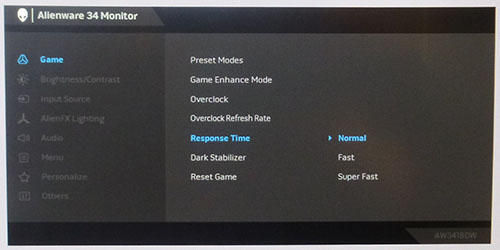
The part being used is the
LG.Display LM340UW4-SSA1 IPS technology panel. This is a new 100Hz native
refresh rate panel, different to the LM340UW2 which was used in models like the
Acer Predator X34/X34a and
Asus ROG Swift PG348Q (60Hz native). Have a read about response
time in our
specs section if you need additional information about this measurement.
We use an
ETC M526
oscilloscope for these measurements along with a custom photosensor device.
Have a read of
our response time measurement article for a full explanation of the testing
methodology and reported data.

Response Times
60Hz Refresh Rate



First of all we tested the screen at a 60Hz
refresh rate in each of the response time settings. In the 'normal' mode the
average G2G response time of 9.2ms was moderate, leaving it a small amount
behind the best 60Hz IPS panel measurements we have seen. In the best cases a
60Hz IPS panel seems to be able to reach down to around 8.5ms G2G without any
noticeable overshoot becoming a problem. There was a small amount of overshoot
here in the 'normal' mode, but nothing major, and the 9.2ms G2G was only a
little behind those best example measurements.
If you push the response time settings up
further to the 'Fast' mode you can see a nice drop in the response times down to
7.8ms G2G. However, some fairly significant overshoot starts to appear on the
rise times, giving rise to pale haloes and overshoot on moving content. In
practice it's not overly obvious and you may find you prefer the small
improvement in motion clarity from the faster response times. The pale overshoot
does
gets worse if you push up to the highest 'Super Fast' response time mode, and the artefacts become more noticeable. For 60Hz content including games
consoles and external devices we would recommend the 'Normal' setting to avoid
any noticeable overshoot, or you may also want to experiment with the 'Fast'
setting perhaps as long as the pale overshoot doesn't start to become too
noticeable. See our pursuit camera pictures in a moment for some visual
indication of the response times.
100Hz
Refresh Rate



The AW3418DW has a native 100Hz IPS panel and
so we went ahead and measured the response times at this refresh rate as well.
In the normal mode, the response times had improved a little, down to 8.5ms G2G
and also removing the slight overshoot we'd seen at 60Hz. The 'Fast' mode was
down to 6.4ms G2G and again some of the overshoot had been reduced, meaning it
was more useable than at 60Hz. However, the pale halos and overshoot were still noticeable on moving
content and we would therefore probably recommend sticking with the 'Normal' mode again.
The 'Super Fast' mode produced too much overshoot still, leading to noticeable
trails and obvious pale halos on moving content. The response times even in the lowest
'normal' mode were fast enough to keep up with the frame rate demands of a 100Hz
refresh rate, where a new frame is sent to the screen every 10ms. If response
times are regularly slower than the frame rate, it can lead to additional
smearing and blurring on moving content. Thankfully that wasn't an issue here.
See our pursuit camera pictures in a moment for some visual indication of the
response times.
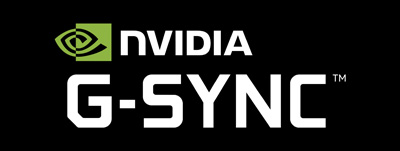
The screen supports NVIDIA G-sync as well for
dynamic refresh rates. This controls a refresh range between 30 and 100Hz in
normal operation, or up to 120Hz if you enable the overclocking feature (more
below). We would recommend sticking with a 'normal' response time setting if you
are using G-sync as this seemed to be optimal for pixel response times across
the full range of refresh rates, and avoided the pale overshoot that appeared in
the 'Fast' mode, particularly at the higher end of the refresh rate range.

Overclocked Refresh Rate
Some of the older 34" ultrawide IPS gaming screens like the
Acer Predator X34 and
Asus ROG Swift PG348Q operated with a 60Hz native refresh rate panel,
offering an overclock up to 100Hz. Here, the Dell Alienware AW3418DW has a 100Hz
native refresh rate panel from LG.Display, but is capable of offering an
overclock up to 120Hz maximum.
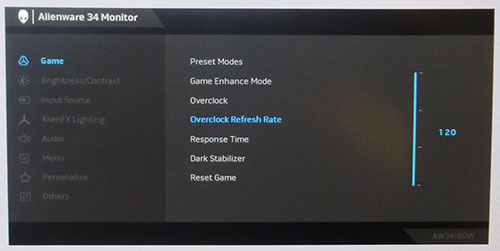
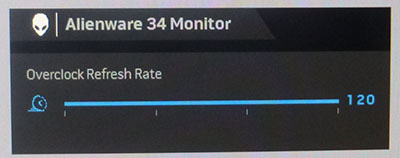
This feature can be quickly and easily
enabled via the OSD menu (top image above), and once activated you can select the overclock limit
as 105, 110, 115 or 120Hz. There is also a quick launch access option available
(bottom image above) if you wanted to quickly change the overclocked refresh
rate, although we suspect that once you've settled on a stable option that works
for you, it's unlikely you'd want to change it again. This accounts for variations in systems as the
overclock is not guaranteed and there is a chance of some flicker occurring in
some cases according to the user manual. Performance may vary from one graphics card to
another and from one system to another. We found that even the maximum 120Hz
overclock produced a stable image, with no artefacts or flicker, and most
importantly no frames being dropped in our tests
which was great news.



We measured the response times at a couple of
the overclocked refresh rates as well. Above we have provided a comparison in
the 'Normal' response time mode at the native 100Hz maximum, and then at 110Hz
and 120Hz overclocked levels. The higher response time settings of 'Fast' and
'Super Fast' produced too much overshoot we felt at these refresh rates, and so
it is best to stick with the 'Normal' mode here again.
At 110Hz refresh rate the response times had
been improved quite nicely, offering a decent bump from 100Hz and down to 6.9ms
G2G now. There was no noticeable overshoot either which was great news. At 120Hz
there was another small improvement down to 6.6ms G2G, and any small overshoot
from before had also been eliminated. The response times in the overclocked
refresh rates were again fast enough to keep up with the frame rate demands,
meaning there was no additional blurring or smearing introduced thankfully. For
instance at 120Hz a new frame is sent to the screen every 8.33ms, and so with
response times of 6.9ms G2G they were perfectly fine.
Pursuit Camera Tests - Motion Clarity
We've already tested above the actual
pixel response
times and other aspects of the screen's gaming performance. We wanted to
carry out some pursuit camera tests as well to give an even more complete idea
of the performance of this screen.
Pursuit cameras are used to capture motion
blur as a user might experience it on a display. They are simply cameras which
follow the on-screen motion and are extremely accurate at measuring motion blur,
ghosting and overdrive artefacts of moving images. Since they simulate the eye
tracking motion of moving eyes, they can be useful in giving an idea of how a
moving image appears to the end user. It is the blurring caused by eye
tracking on continuously-displayed refreshes (sample-and-hold) that we are keen
to analyse with this new approach. This is not pixel persistence caused by
response times; but a different cause of display motion blur which cannot be
captured using static camera tests. Low response times do have a positive impact
on motion blur, and higher refresh rates also help reduce blurring to a degree.
It does not matter how low response times are, or how high refresh rates are,
you will still see motion blur from LCD displays under normal operation to some
extent and that is what this section is designed to measure. Further
technologies specifically designed to reduce perceived motion blur are required
to eliminate the blur seen on these type of sample-and-hold displays which we
will also look at.
We used the
Blurbusters.com Ghosting Motion Test which is designed to be used with
pursuit camera setups. The pursuit camera method is
explained at BlurBusters
as well as
covered in this research paper. We
carried out the tests at a range of refresh rates, in each of the 'response
time' settings. These UFO objects were moving horizontally at 960 pixels per second, at
a frame rate matching refresh rate of the monitor.
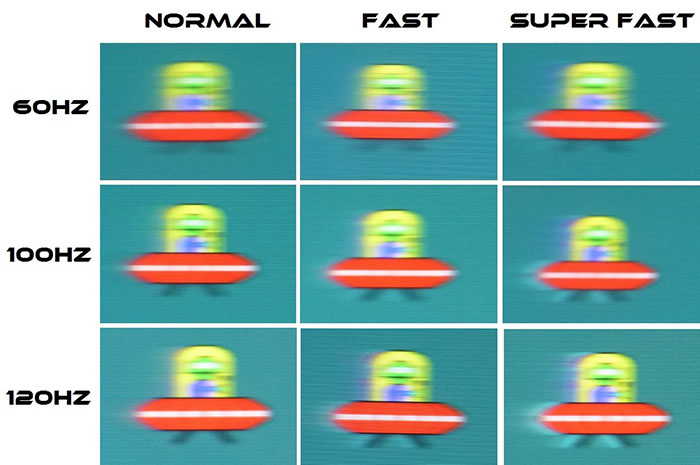
We saw some noticeable improvements in motion
clarity as you increase the refresh rate which was easy to spot with the naked
eye, and captured quite nicely with the pursuit camera photos above. It is
probably sensible to stick with the 'normal' response time mode which avoided
any noticeable overshoot, certainly as you reached the higher refresh rates
where it had been eliminated almost entirely. The moving UFO image became
sharper and easier to track as you increased the refresh rate as you might
expect. There was actually quite a nice improvement as you increased from 100Hz
to 120Hz, thanks to the additional frame rate, but also as a result of the
improved response times, where they had dropped form 8.5ms to 6.9ms G2G. It's a
little hard to pick out with the pursuit camera, but you could spot improvements
in actual use more clearly. The jump is not as significant as the change from 60
to 100Hz but we felt it still offered some benefit. It will also support higher
frame rates up to 120fps of course which is important to some gamers.
The 'Fast' response time mode might be useful
to some people although we felt that the pale halos were a bit too noticeable,
certainly at the higher refresh rates where the reduction in blurring made the
overshoot more visible to the naked eye. The 'Super Fast' mode was definitely
too aggressive, and the pale halos were very obvious as you can see above,
especially again at the higher refresh rates.
There is no
blur reduction backlight system offered sadly on this screen, despite the
higher refresh rate support. So you cannot get any additional motion clarity
benefits from a strobed backlight. It should be noted that other 34" ultrawide
models like the
Acer Predator X34 and
Asus ROG Swift PG348Q also do not offer any blur reduction backlight.

Scanlines? updated 10/11/17 - we had a
few questions about this since publishing the review so took the chance to go
back and do some further testing. On some G-sync screens, including the Acer and
Asus 34" models we've talked about a lot in this review, some users complained
of a so-called "scanlines" issue when using the G-sync feature. The reports are
that when you enable G-sync, some very faint horizontal lines appear on the
background, and some users have found this distracting. It seems that the
typical "test" for scanlines is to use the NVIDIA G-sync pendulum demo, and look
at the grey background while toggling between G-sync on and off settings. This
can help you identify and find the scanlines, although it's not really clear
whether it's really a major concern in normal uses and gaming. It's all very
well specifically looking for it with something like the pendulum demo, but you
do need to consider whether it will affect you for actual uses. It seems some
reports are that the issue becomes worse at higher refresh rates and with
overclocks, although information is a little patchy. A reported official
response from Acer on the matter suggests that it is caused by the dynamic
refresh rates and changing frame rates which would seem a logical explanation as
to why something like this might appear, and only when G-sync is being used.
It's not something we noticed during our
testing of the Acer and Asus models at the time. Nevertheless, we had the
opportunity to specifically search for it here with the AW3418DW. We ran the
pendulum demo and switched between G-sync on and off. If you look very closely
at the grey background you can see some slight differences. A very faint
horizontal pattern appears and you see some slight shimmering of the image on
some colours. It is very, very slight, and you can only really detect it if you
look very closely at the screen from a short distance. Moving back a typical
viewing position makes it very hard, or almost impossible to spot in our
opinion. Using the screen without G-sync removes any sign of these slight
artefacts. It seemed to be the same faint pattern at all refresh rates, with the
120Hz overclock not making it any different.
We are not sure whether it is any more or
less apparent than on the Acer and Asus models since we didn't specifically look
for the issue at the time. Our advice would be that if you are super-sensitive,
previously had issues with other similar G-sync screens or really found it a
major problem for your uses in the past, perhaps it might be a problem for you
again here. However, we would say that most users really do no not need to worry
about it, it's so subtle that we feel it would be very hard to detect in normal
uses, from a normal viewing position and without specifically searching for it.
It's probably one of those situations where it's better to not go searching for
defects and just enjoy the new screen.

Detailed Response Time Measurements
Having taken a small number of measurements above to test the response times at
each refresh rate, we extended the range of transitions measured here. We took
these measurements at the maximum 120Hz overclocked refresh rate, as that was
stable on our system with no frames being dropped and delivered the fastest
response times - and best motion clarity also. The 'response time' setting was
left at 'Normal' as we felt that the overshoot and pale halos on the other modes
become too distracting.
Response Time = Normal
Refresh Rate = 120Hz
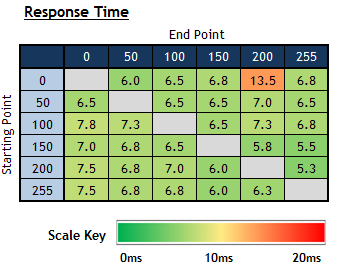
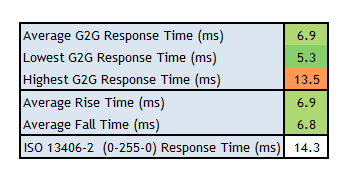
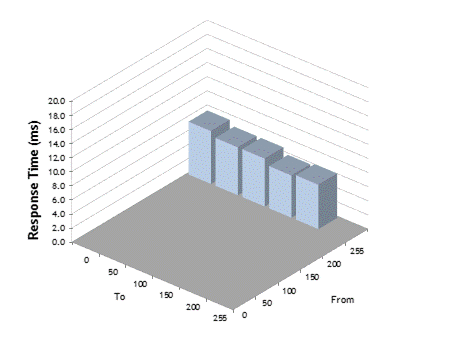
The average G2G response time was more accurately
measured at 6.9ms now. There was one anomalous measurement where the response
time was slightly slower at 13.5ms, but on the whole the average rise and fall
times were very similar. The response times were fast enough to keep up with the
120Hz frame rate demands as well, which require a new frame to be sent to the
screen every 8.33ms.
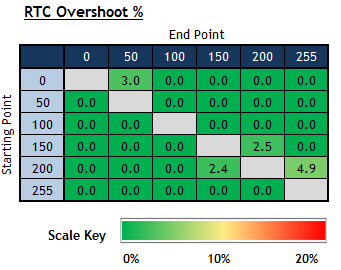
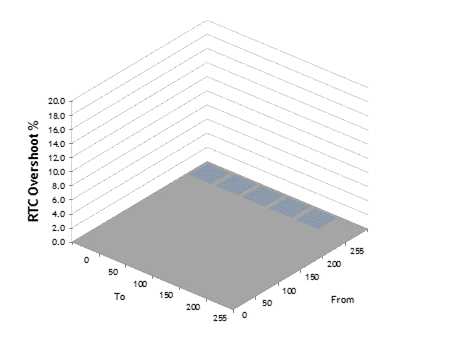
There is no noticeable overshoot on any transition
in this 'normal' response time mode at 120Hz, so there was no added trailing or artefacts from
an overly aggressive overdrive impulse. This was a great result for an IPS
panel.

Gaming Comparisons
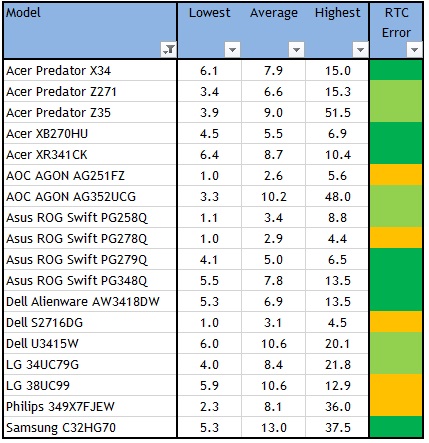
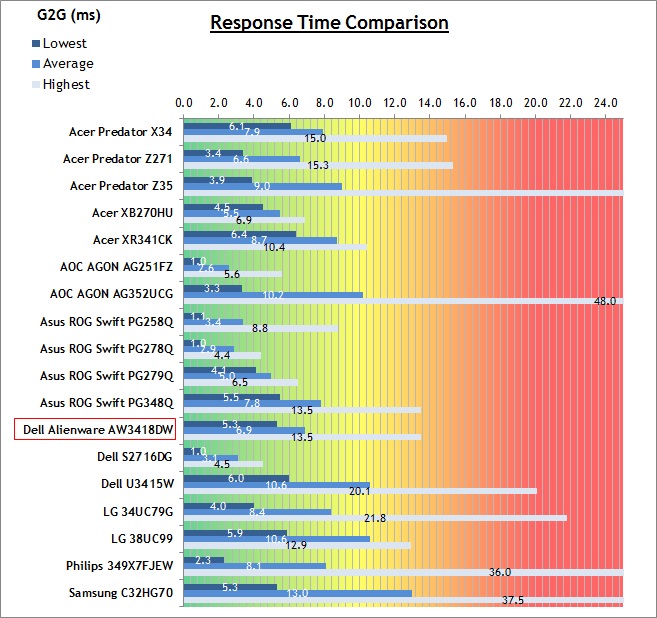
The above comparison table and graph shows you the
lowest, average and highest G2G response time measurement for each screen we
have tested with our oscilloscope system. There is also a colour coded mark next
to each screen in the table to indicate the RTC overshoot error, as the response
time figure alone doesn't tell the whole story.
These comparisons show a very good result for
the Dell Alienware AW3418DW. With a 120Hz maximum overclocked refresh rate, it
offers a 20% boost in supported frame rate compared with competing models like
the
Acer Predator X34/X34a and
Asus ROG Swift PG348Q (100Hz maximum). This
brings about some improvements in motion clarity in practice thanks to the
higher refresh rate. It also leads to faster response times which is positive
news as well. The AW3418DW has an average 6.9ms G2G, and freedom from any
overshoot. This was a little faster than the Acer Predator X34 (7.9ms G2G) and
Asus ROG Swift PG348Q (7.8ms G2G) which was great news.
High refresh rate 27" IPS models can reach a
little faster, with response times down to around 5ms G2G from models like the
Asus ROG Swift PG279Q and
Acer Predator XB270HU. Those 27" screens have a higher
native 144Hz refresh rate, and a panel from AU Optronics which seems to be able
to offer faster response times than these equivalent 34" ultrawide panels from
LG.Display. Still, in the ultrawide market this was the fastest model we have
seen so far both from a response time and refresh rate point of view (assuming
the same 3440 x 1440 resolution). Other competing screens with VA panels could
not quite keep up, with most also suffering from some slow rise times and
resulting in some dark smearing on moving content. TN Film models are the
fastest still when it comes to pixel response times, and some screens will also
offer refresh rates up to 240Hz native now. So if you want the absolute fastest
screen for gaming with very quick response times, and the highest refresh rate
possible then those TN Film screens are probably your best bet. In the ultrawide
gaming market, the Alienware AW3418DW is now our benchmark for response times
and refresh rate.

Additional Gaming Features
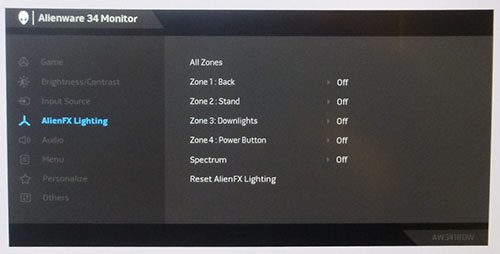
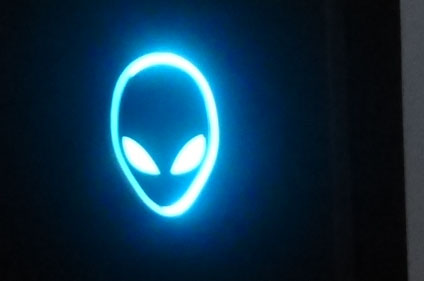
-
AlienFX
lighting system - the Dell
documentation explains this system as follows: "a fully customizable RGB
lighting system designed to bring you closer to the worlds you play in with
dynamic lighting effects tied directly to the in-game action. Four customized
lighting zones let you personalize your keyboard, monitor and mouse with
different colours
and effects to reflect your style. Create and download unique themes
effortlessly for over 145 different games."
On the screen there is a whole menu dedicated to this lighting system as
shown above. There are 4 zones that you can control individually, setting
different colours for strips on the back of the screen, back of the stand,
bottom edge of the display and the small power button LED. You can have these
colours cycle as well if you want. There's also a small Alien logo on the back
of the screen as pictured above which syncs with the colour you set for the
back strips. It was a very nice lighting system we felt, although a lot of the
lights are on the back of the screen so depending on how you position the
display, you may not really see them ever. The bottom edge lighting casts a
nice glow, and there was a really wide range of colour options to choose from.
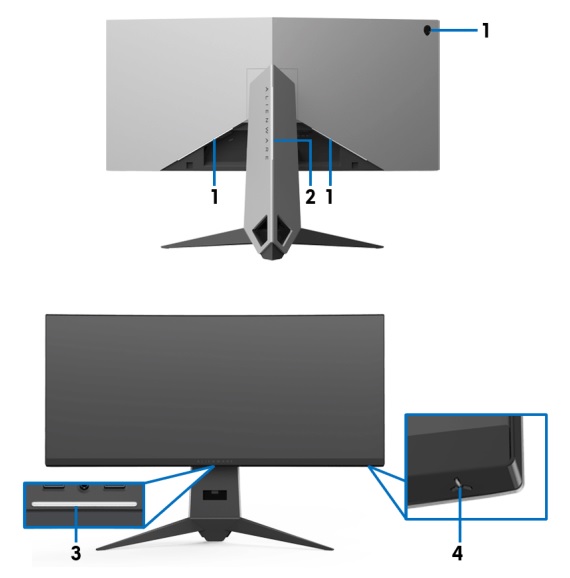
Above: AlienFX lighting locations on the back (1), stand (2), Alien face in top
right (1), underside (3) and power LED (4).
-
Aspect Ratio Control -
the screen doesn't offer any
hardware level
aspect ratio control
options, probably related to the use of a G-sync module in place of any
internal scaler. This is not really a problem for PC gaming as you should be
able to control the aspect ratio via your graphics card if you need to,
although quite a lot of modern games support this ultrawide 21:9 aspect ratio
format now too. When connecting external devices it may create a problem if
the source is in a different aspect ratio like 16:9.

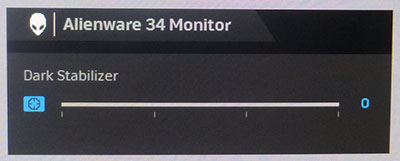
-
Black
Stabilizer - There is a setting available in the 'game' section of
the OSD menu and via the quick launch menu as pictured above which allows you to adjust the brightness of
the dark areas of games. We've seen this kind of feature on other screens
before and it can be handy where you are in a lot of dark environments to
bring out some shadow detail.
-
Timer, Frame Rate, Display Alignment - There are a few additional settings
within the 'game' section of the menu. This includes a stopwatch timer
function, a counter for your active frame rate and a feature to align the
video content of multiple displays. The frame rate counter is particularly
useful if you're keeping an eye on your frame rate and performance, as well as
fluctuations using G-sync.

Lag
We have written an in depth article about
input lag and the various measurement techniques which are used to evaluate
this aspect of a display. It's important to first of all understand the
different methods available and also what this lag means to you as an end-user.
Input Lag vs. Display Lag vs. Signal
Processing
To avoid confusion with different terminology we
will refer to this section of our reviews as just "lag" from now on, as there
are a few different aspects to consider, and different interpretations of the
term "input lag". We will consider the following points here as much as
possible. The overall "display lag" is the first, that being the delay between
the image being shown on the TFT display and that being shown on a CRT. This is
what many people will know as input lag and originally was the measure made to
explain why the image is a little behind when using a CRT. The older stopwatch
based methods were the common way to measure this in the past, but through
advanced studies have been shown to be quite inaccurate. As a result, more
advanced tools like SMTT provide a method to measure that delay between a TFT
and CRT while removing the inaccuracies of older stopwatch methods.
In reality that lag / delay is caused by a
combination of two things - the signal processing delay caused by the TFT
electronics / scaler, and the response time of the pixels themselves. Most
"input lag" measurements over the years have always been based on the overall
display lag (signal processing + response time) and indeed the SMTT tool is
based on this visual difference between a CRT and TFT and so measures the
overall display lag. In practice the signal processing is the element which
gives the feel of lag to the user, and the response time of course can
impact blurring, and overall image quality in moving scenes. As people become
more aware of lag as a possible issue, we are of course keen to try and
understand the split between the two as much as possible to give a complete
picture.
The signal processing element within that is quite
hard to identify without extremely high end equipment and very complicated
methods. In fact the studies by Thomas Thiemann which really kicked this whole
thing off were based on equipment worth >100,1000 Euro, requiring extremely high
bandwidths and very complicated methods to trigger the correct behaviour and
accurately measure the signal processing on its own. Other techniques which are
being used since are not conducted by Thomas (he is a freelance writer) or based
on this equipment or technique, and may also be subject to other errors or
inaccuracies based on our conversations with him since. It's very hard as a
result to produce a technique which will measure just the signal processing on
its own unfortunately. Many measurement techniques are also not explained and so
it is important to try and get a picture from various sources if possible to
make an informed judgement about a display overall.
For our tests we will continue to use the SMTT
tool to measure the overall "display lag". From there we can use our
oscilloscope system to measure the response time across a wide range of grey to
grey (G2G) transitions as recorded in our
response time
tests. Since SMTT will not include the full response time within its
measurements, after speaking with Thomas further about the situation we will
subtract half of the average G2G response time from the total display lag. This should allow us to give a good estimation of
how much of the overall lag is attributable to the signal processing element on
its own.
Lag Classification
To help in this section we will also introduce a broader classification system
for these results to help categorise each screen as one of the following levels:
-
Class 1)
Less than 6.94ms / 1 frame lag at 144Hz - should be fine for gamers, even at high levels
-
Class
2)
A lag of 6.94 -
13.88ms / One to two frames at 144Hz - moderate lag but should be fine for many gamers.
Caution advised for serious gaming
-
Class
3)
A lag of more
than 13.88ms / more than 2 frames at 144Hz - Some noticeable lag in daily usage, not
suitable for high end gaming
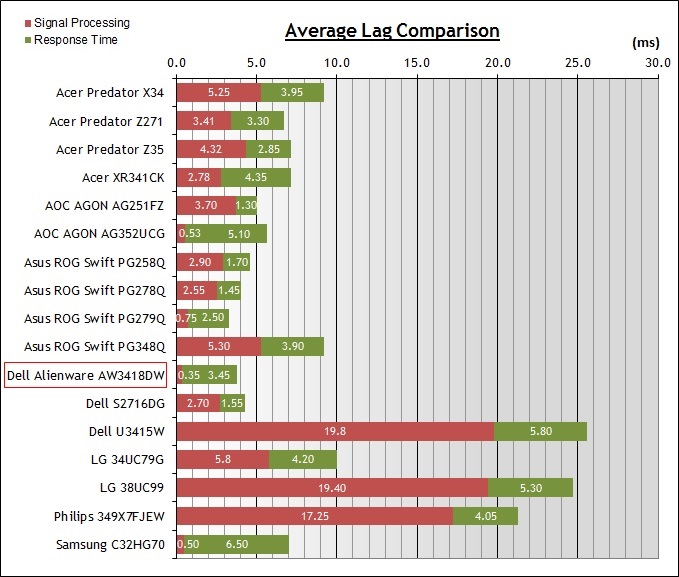
For the full reviews of the models compared here and the dates they were written
(and when screens were approximately released to the market), please see our
full
reviews index.
|
(Measurements in ms) |
|
|
Total Display Lag (SMTT
2) |
3.80 |
|
Pixel Response Time
Element |
3.45 |
|
Estimated Signal
Processing Lag |
0.35 |
|
Lag Classification |
1 |
|

Class
1 |
We have provided a comparison above against other
models we have tested to give an indication between screens. The screens
tested are split into two measurements which are
based on our overall display lag tests (using SMTT) and half the average G2G
response time, as measured by the oscilloscope. The response time is split from
the overall display lag and shown on the graph as the green bar. From there, the
signal processing (red bar) can be provided as a good estimation.
We measured a total display lag of only
3.80ms, which was applicable at various refresh rates (including the maximum
overclocked 120Hz). With approximately 3.45ms of that accounted for by pixel
response times we had an estimated signal processing of only 0.35ms; basically
nothing. This was an excellent performance making the screen fully suitable for
fast gaming needs. You will note that all of the G-sync screens have next to no
lag at all, typically 0 - 5ms maximum which is nothing to worry about. This is a
benefit of the G-sync module, and also the lack of an added scaler to the
screen. The Acer Predator X34 and Asus ROG Swift PG348Q were slightly higher at
5.25 - 5.30ms signal processing lag. Obviously nothing really at all to worry
about, for the ultra-sensitive the Dell surpasses those screens here.
You can see that other models such as the
Philips 349X7FJEW and
LG 38UC99 for instance have a higher signal processing lag which is a result
of the scaler added to the screen. Those are FreeSync models and it's not always
easy to keep the lag down on FreeSync screens. The
Samsung C32HG70 with FreeSync support offers a low input lag mode though to
bypass some of those internal electronics so it is possible, it just needs
additional measures to be put in place.

Movies and Video

The following summarises the screens performance
in video applications:
-
34"
screen size makes it a good option for an all-in-one multimedia screen, but
being quite a bit smaller than most modern LCD TV's of course even at this
massive size.
-
21:9 aspect ratio is more well suited to videos, more so than the wide range
of 16:9 format screens around, leaving smaller borders on DVD's and wide
screen content at the top and bottom.
-
3440 x 1440 resolution can support full 1080 HD resolution content
-
Digital interfaces support HDCP for any encrypted and protected content
-
Fairly limited range of connectivity
options provided with only 1x DisplayPort, 1x HDMI 1.4 offered. A restriction
of G-sync at the moment.
-
Cables provided in
the box for DisplayPort connections
only.
-
Light AG coating providing clean and clear images, without the unwanted
reflections of a glossy solution.
-
Wide brightness range adjustment possible from the display, including a
maximum luminance of ~256
cd/m2 and a fairly decent minimum luminance of 24 cd/m2.
This should afford you good control for different lighting conditions.
Brightness regulation is controlled without the need for PWM and so is flicker
free for all brightness settings.
-
Black depth and contrast ratio are ok, but not brilliant at 840:1 after
calibration. Detail in darker scenes should still not be lost although it
can't offer the contrast ratio of some competing IPS models which can reach
nearer to 1100:1, and certainly VA panels which are often 2000:1 - 3000:1.
-
There are no specific preset modes for movies or cinema on this model although
you could easily set up one of the user game modes if you wanted something
different.
-
Very good pixel responsiveness which should be able to handle fast moving
scenes in movies without issue. Best to stick with the 'normal' response time
mode which we found was optimal. This is particularly true for 60Hz refresh
rates when connecting external devices like consoles and Blu-ray players.
-
Wide viewing angles from IPS panel
technology meaning several people could view the screen at once comfortable
and from a whole host of different angles. White IPS glow from an angle may be
an issue for some darker content.
-
No real backlight bleeding or leakage which
is good, as this can be particularly problematic for movies where black
borders are present.
-
Good tilt, height and swivel adjustment
range available from the stand making it pretty easy to re-position the screen
for movie viewing from a distance, or with other people.
-
No integrated speakers available on this model, although there is a headphone
output if you want. The Acer Predator X34 and Asus ROG Swift PG348Q did
feature some speakers if that is important to you, although they are only
really suitable for the odd YouTube video or mp3.
-
No
hardware aspect ratio control options available. Not a problem for PC movie
viewing but external devices may be an issue given differing aspect ratios.
-
Picture By Picture (PbP) and Picture In Picture (PiP) are not available on
this model.
-
HDR is not supported on this display.

Conclusion
The
If you appreciate the review and enjoy reading and like our work, we would welcome a
donation
to the site to help us continue to make quality and detailed reviews for you.
The AW3418DW was an impressive new option in
the 34" ultrawide IPS gaming market. It's definitely a preference to have a full
3440 x 1440 resolution on these models we think, as this provides a much sharper
image, more desktop real estate and is better for all-round uses. The fact that
Dell have made use of a new 100Hz native refresh rate panel from LG.Display here
sets it apart from the competition at the moment, which rely on 60Hz panels that
can be overclocked to 100Hz, or a little less than that in some cases. Here, the
100Hz should be stable for everyone, and then there's also an additional 120Hz
overclock offered which we found worked really well. It was stable on our system
with no frame drops, and resulted in improved motion clarity due to the 20%
increase in frame rates as well as helping to improve response times to as low
as we've seen on a 34" IPS screen. This monitor is now the benchmark for
ultrawide gaming response times and refresh rates. The input lag was also
non-existent, and there was a nice range of additional features like the AlienFX
lighting and Black Stabilizer for instance which added to the premium feel.
The large resolution and screen size make it
a good option as well for all-round uses, not just for the intended gaming
applications. The default setup wasn't perfect, as the gamma was a bit off and
contrast ratio was not quite as good as we'd seen from some other modern IPS
panels. Still, the IPS panel offered the wide viewing angles, stable image, sRGB
gamut and nice image quality that we're used from this technology. The flicker
free backlight was a positive, and the very good stand provided a sturdy support
for the screen with all the necessary adjustments available including the
sometimes missing swivel.
The default setup and the contrast ratio
might not be quite as good as the popular Acer and Asus 34" IPS models, but we
felt the Alienware AW3418DW was a better screen. The gaming performance is what
is of most importance here, and with the faster response times, native 100Hz,
increased 120Hz overclock and zero lag we feel this is currently the best 34"
gaming option that we have tested.
|
Pros |
Cons |
|
120Hz overclocked refresh
rate works very well, with no frame drops and improved motion clarity |
Default gamma setup was a
little off for general uses |
|
Response times as low as
we have seen from any ultrawide screen to date |
Contrast ratio not quite
as high as other modern IPS panels |
|
Zero lag, and nice
additional gaming features |
Would love to see an
ultrawide IPS with a blur reduction backlight option as well |
|
Check Pricing and Buy - Direct Links
|
|
Amazon
|
|
TFTCentral is a participant
in the Amazon Services LLC Associates Programme, an affiliate
advertising programme designed to provide a means for sites to earn
advertising fees by advertising and linking to Amazon.com, Amazon.co.uk,
Amazon.de, Amazon.ca and other Amazon stores worldwide. We also
participate in a similar scheme for Overclockers.co.uk. |
|

|
TFT Central Awards Explained
We have two award
classifications as part of our reviews. There's the top 'Recommended'
award, where a monitor is excellent and highly recommended by us. There is
also an 'Approved' award for a very good screen which may not be perfect,
but is still a very good display. These awards won't be given out every
time, but look out for the logo at the bottom of the conclusion. A list of
monitors which have won our awards is available
here. |